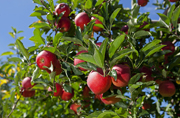
November 5, 2024. The Northern New York Agricultural Development Program (NNYADP) has released the preliminary results of an evaluation of a new orchard thinning product that may help apple growers overcome challenging temperatures. The region’s cool spring temperatures can interfere with an orchard’s ability to reach optimal crop load that drives yield and income opportunity.
Northern New York’s apple growers are in search of alternative methods of thinning their crop, particularly after seeing poor results with some traditional thinners in the 2018, 2019, 2020, and 2022 seasons, leading to small fruit size in some varieties and poor return bloom of Honeycrisp, one of the region’s most economically valuable apple varieties, in 2019 and 2021.
Apple growers periodically thin a portion of the blossoms or young fruitlets from their trees to support optimal crop lead for improved apple size and quality at harvest. Tree Fruit Specialist Michael Basedow, with Cornell Cooperative Extension, notes, “Thinning at traditional spring timings is particularly challenging in Northern New York as thinning treatments are heavily driven by, and temperatures here are often too cool for good thinning efficacy.”
An additional challenge is that once the apples reach a size larger than 24 millimeters, the fruit is unresponsive to standard thinning materials and substantial hand-thinning labor becomes necessary or cost-prohibitive.
When a new thinning product was announced with the potential to work under Northern New York’s often cooler temperatures, Basedow proposed orchard trials for 2023. The trials received funding from the farmer-driven NNYADP.
“The questions to be answered are could this new product be a more reliable material for growers to use during the late window of time before fruit becomes unresponsive to thinning, and how much efficacy could we expect compared to thinning with traditional materials at bloom, petal fall, and fruit set,” Basedow explains.
Orchards in Chazy and Peru, New York, participated in the first-year trials. Four different thinning treatments were applied to three varieties of apple: Gala, Honeycrisp, and Macoun.

First-Year Results Varied by Location and Variety
Results varied by location and variety. In some cases, no difference among the treatments was seen in the number of Gale or Honeycrisp fruit per tree or yield, suggesting the new product could potentially be used in place of some other thinners if weather is not cooperative at the earlier thinning timings.
A significant increase in Gala fruit size was measured in one Gala treatment when the trees were thinned at petal fall, 12 mm, and with the new product under evaluation at 20mm. At another site, significant differences were recorded in Macoun fruit number per tree and yield with the new product, but no significant gain in fruit size or color, while the use of the product at another site improved Honeycrisp fruit color.
A mid-May freeze impacted the research results in at least one orchard where the extreme temperature lasted four hours.
“As a first-year evaluation, mixed results are often the case and backstop the need for trials in multiple years under varying conditions. More data will be added before any conclusions can be made,” Basedow says.
The impact on return bloom will be reported with the 2024 harvest data in the second-year research results report expected early in 2025. The report will be posted at www.nnyagdev.org.

Funding for the Northern New York Agricultural Development Program is supported by the New York State Legislature through the New York State Assembly and administrated by the New York State Department of Agriculture and Markets.